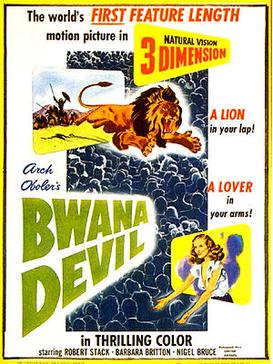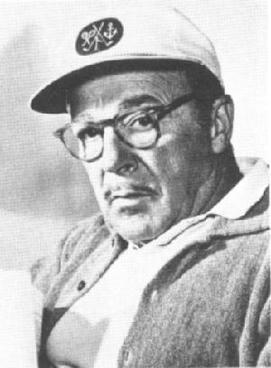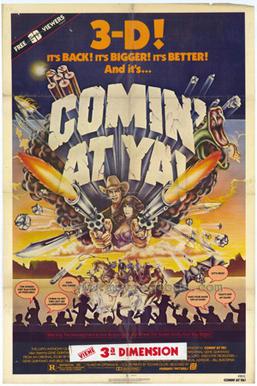Related Research Articles

Capucine was a French fashion model and actress known for her comedic roles in The Pink Panther (1963) and What's New Pussycat? (1965). She appeared in 36 films and 17 television productions between 1948 and 1990.

Robert Stack was an American actor and television host. Known for his deep voice and commanding presence, he appeared in over forty feature films. He starred in the ABC television series The Untouchables (1959–1963), for which he won the 1960 Primetime Emmy Award for Outstanding Performance by an Actor in a Series, and later hosted/narrated the true-crime series Unsolved Mysteries (1987–2002). He was also nominated for an Academy Award for Best Supporting Actor for his role in the film Written on the Wind (1956). Later in his career, Stack was known for his deadpan comedy roles that lampooned his dramatic on-screen persona, most notably as Captain Rex Kramer in Airplane! (1980).

Bwana Devil is a 1952 American adventure B movie written, directed, and produced by Arch Oboler, and starring Robert Stack, Barbara Britton, and Nigel Bruce. Bwana Devil is based on the true story of the Tsavo maneaters and filmed with the Natural Vision 3D system. The film is notable for sparking the first 3D film craze in the motion picture industry, as well as for being the first feature-length 3D film in color and the first 3D sound feature in English.

Lights Out is an American old-time radio program devoted mostly to horror and the supernatural.

The Twonky is a 1953 independently made American black-and-white science fiction/comedy film, produced by A.D. Nast, Jr., Arch Oboler, and Sidney Pink, written and directed by Arch Oboler, and starring Hans Conried, Gloria Blondell, Billy Lynn, and Edwin Max. The film was distributed by United Artists.

Reptilicus is a 1961 Danish-American monster film about a prehistoric reptile. The film was produced by Cinemagic and Saga Studio and separate versions were released in Denmark and in the United States, with American International Pictures handling distribution for the latter.

Gordon Douglas Brickner was an American film director and actor, who directed many different genres of films over the course of a five-decade career in motion pictures.
Joseph Francis Biroc, ASC was an American cinematographer. He was born in New York City and began working in films at the Paragon Studios in Fort Lee, New Jersey. After working there for approximately six years, he moved to Los Angeles. Once in Southern California, Biroc worked at the RKO Pictures movie studio. During World War II, he served in the U.S. Army Signal Corps and filmed the Liberation of Paris in August 1944. In 1950, Biroc left RKO Pictures and freelanced on projects at various studios. In addition to his film work, which included It's a Wonderful Life (1946) and The Flight of the Phoenix (1965), Biroc worked on various television series, including the Adventures of Superman and Wonder Woman. He frequently collaborated with film director Robert Aldrich.

Arch Oboler was an American playwright, screenwriter, novelist, producer, and director who was active in radio, films, theater, and television. He generated much attention with his radio scripts, particularly the horror series Lights Out, and his work in radio remains the outstanding period of his career. Praised as one of broadcasting's top talents, he is regarded today as a key innovator of radio drama. Oboler's personality and ego were larger than life. Radio historian John Dunning wrote, "Few people were ambivalent when it came to Arch Oboler. He was one of those intense personalities who are liked and disliked with equal fire."

Comin' at Ya! is a Spanish-American 3D Western film, featuring Tony Anthony, Victoria Abril and Gene Quintano and directed by Ferdinando Baldi.
Norman Krasna was an American screenwriter, playwright, producer, and film director who penned screwball comedies centered on a case of mistaken identity. Krasna directed three films during a forty-year career in Hollywood. He garnered four Academy Award screenwriting nominations, winning once for 1943's Princess O'Rourke, which he also directed.

Top Banana is a 1954 American musical film based on the musical of the same name, starring Phil Silvers, and featuring Rose Marie, Judy Lynn, Jack Albertson and Joey Faye, all of whom reprised their roles from the Broadway production of the musical.

Journey to the Seventh Planet is a 1962 Danish-American science fiction film. It was directed by Sid Pink, written by Pink and Ib Melchior, and shot in Denmark with a budget of only US$75,000.
Ann Smyrner was a Danish actress who was active in the 1960s in Italy, the United States, Austria and West Germany. She played in adventure, comedy, science fiction, crime, and horror movies, among which are the Sidney Pink science fiction movies Reptilicus and Journey to the Seventh Planet.
Camillia Monet is an American actress and film producer. She began her career in acting, appearing in films such as War of the Worlds (2005), directed by Steven Spielberg, playing opposite Tom Cruise, and Seabiscuit (2003), opposite Tobey Maguire.
Jenny Lumet is an American actress and screenwriter. She is the daughter of director Sidney Lumet and granddaughter of Lena Horne. Lumet is perhaps most known for writing the original screenplay of the 2008 Jonathan Demme film Rachel Getting Married, and her work on the Star Trek franchise.
Milton Lowell Gunzburg was an American journalist and screenwriter. Gunzburg developed the Natural Vision stereoscopic 3-D system.

The Castilian is a 1963 independently made historical action film drama in Eastmancolor, produced by Sidney W. Pink, directed by Javier Setó, that stars Cesar Romero, Frankie Avalon, Broderick Crawford, Alida Valli, Espartaco Santoni, Tere Velázquez, Fernando Rey, and Soledad Miranda. The Castilian was distributed in the U.S. by Warner Bros. Pictures.
Michael Jeffrey Lloyd is an American record producer, arranger, songwriter and musician. After working with Mike Curb, Kim Fowley and others in the mid-to-late 1960s on musical projects including the West Coast Pop Art Experimental Band, and Steven Spielberg's first short film, Amblin', he became a producer of such teen idol pop stars as the Osmonds, Shaun Cassidy and Leif Garrett in the 1970s.
José María Elorrieta (1921–1974) was a Spanish screenwriter and film director. He wrote or directed a number of Spaghetti Westerns.
References
- ↑ Pink, Sidney (1989). So You Want to Make Movies: My Life As an Independent Film Producer. Pineapple Press, Inc. pp. 3. ISBN 0-910923-77-9.
- ↑ "Pennsylvania, U.S., Marriages, 1852-1968 for Rose Pink". Ancestry.com. Retrieved August 31, 2022.
- ↑ Pink, Sidney (1989). So You Want to Make Movies: My Life As an Independent Film Producer . Pineapple Press, Inc. pp. 3. ISBN 0-910923-77-9.
- 1 2 3 4 McLellan, Dennis (October 17, 2002). "Sidney Pink, City Native, Film Producer Helped Make First Full-length 3-D Feature". The Los Angeles Times. Los Angeles, California.
- ↑ A.H. Weiler (Mar 30, 1947). "RANDOM NOTES ABOUT PICTURES AND PEOPLE". New York Times. ProQuest 107996424.
- ↑ "Stage, cinema bill proffered". Los Angeles Times. Dec 25, 1947. ProQuest 165835536.
- ↑ McBride, Joseph (1992). Frank Capra: The Catastrophe of Success. ISBN 0-671-79788-3.
- 1 2 3 Johnson, Lawrence A. (October 17, 2002). "S. Pink, Made Low-Budget Films". South Florida Sun-Sentinel. p. 24.
- ↑ "Sidney Pink, 86; Pioneer of 3-D Genre Produced More Than 50 Movies". Los Angeles Times . Retrieved August 31, 2022.
- ↑ "Pink to Film Three More in Denmark". The Los Angeles Times. Los Angeles, California. November 8, 1960.
- ↑ "Dane's Miniature Work the Bestest". Variety. November 1, 1960. Retrieved September 2, 2022.
- ↑ "Producer Sues Victor Mature for $1.1 Million". Los Angeles Times. Dec 8, 1964. p. 24.
- ↑ "Bainbridge Mall Cinemas". Ancestry.com. Retrieved August 31, 2022.